WOLF retro Feature. 14th April 2024
There have been many articles written about the history of Yamaha synthesizers and there are also many websites showcasing brochure collections. With this article we wanted to celebrate both history and brochures in a simple and light hearted manner. This feature explores the many exciting synthesizers produced by Yamaha from 1974 to 1999 through the commercially available brochures of each model. Almost all brochures here are from the WOLF library with many collected in person at the time of release. The chronology of this feature follows what is officially presented by Yamaha and van be seen at:
https://au.yamaha.com/en/products/contents/music_production/synth_chronology/index.html
Disclaimer:
While we have followed Yamaha’s website as a guide, we understand that certain models may not have been available for sale or marketed in a brochure until the following year, and this could make the models in each year seem inaccurate. It is also important to recognise that while we have attempted to showcase every synthesizer with its correct brochure, we do not have access to every brochure ever made, and know that for some models there were multiple variants which we may not have. Certain models such as the EOS synths were also only available in Japan so those brochures only exist with Japanese text.
In the few situations where we could not source a product brochure, we substituted the best we could with another form of sales literature or appropriate image of the product. While our attempt has been to showcase individual product brochures, in some instances it seemed appropriate to include brochures that feature a series of synthesizers or general products catalogs that feature synthesizers.
For clarification, we only included the instruments that were officially publicized by Yamaha as a synthesizer. Electones, electric pianos, controller and home keyboards are therefore not considered in this feature.
1974- 1975- Lets begin!

The SY-1 was the first commercially available synthesizer by Yamaha with SY designating “Synthesizer Yamaha”. It was launched in 1974 and rather quickly superseded the following year by the SY-2. 1975 also saw the mega GX1, but we have yet to sight its original sales brochure.

Yamaha SY-1 & SY-2

This illustrated image is our best fill-in until we find the original sales brochure
1977 -The CS era
In 1977 Yamaha exploded onto the scene with several new CS synthesizers led by their legendary flagship, the CS-80. We believe CS stood for Combo Synthesizer.

Yamaha CS-50 & CS-60

Yamaha CS-80 & CS-series catalog

We are still in search of individual sales brochures for the CS-10, 30, 30L & CS15D, however they are featured in these product catalogs where Yamaha referred to their digital instruments as Combo products.

Yamaha CS-30 & CS-30L
1978 -More CS
1978 saw two new CS modes added to the range, the CS-5 and CS-15.

1979 – D& M variants
1979 saw three more CS models as D and M variants. We also see the birth of the SK series where we understand “SK” to represent “Symphonic Keyboard”

Yamaha CS-20M & CS-40M in basic Black & white
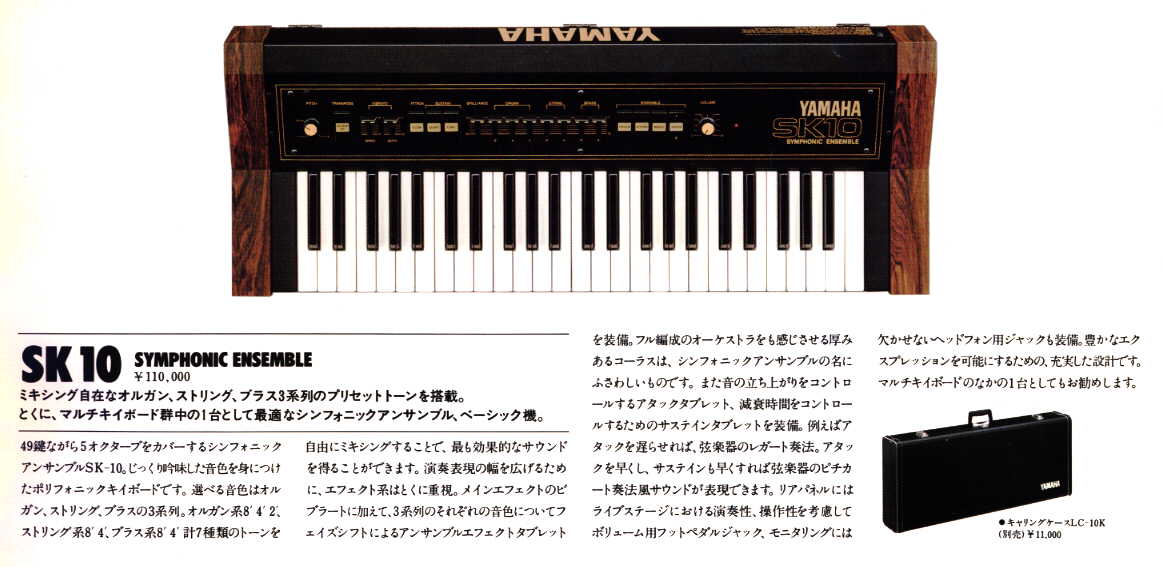
The SK-10 of 1979 was the first of the SK series

We don’t have individual product brochures for the CS-15D and the SK10.
1980 -The SK era
Alongside the CS series, Yamaha pushed forward their SK series. Curiously the hyphen as seen in the CS model names was dropped for the SK names.

We don’t have an individual brochure for the SK-10 but it was featured on the back of the SK20 brochure.


Again, we don’t have the individual brochures for the SK30 & SK50D but they are featured in this A5 landscape profile catalog.
1981 -End of an era and dawn of a new.
1981 saw the CS-70M as a last Harrah to the CS series. Then came the Magnificent GS1 and GS2 synthesizers that were considered as the beginnings of Yamaha’s digital era and birth of FM synthesis.

Left- A rather view illustrated on the cover of the CS70M brochure
Right- We don’t have the brochure for the SK15 but it did feature in product catalogs, often alongside the SK10

The GS2 was essentially a transportable GS1.
1982 -Are we there yet?
If you’re thinking it’s time for some DX synths, we are not quite there yet. Just when you thought the SY and CS names were a thing of the past, Yamaha released the SY20 and CS01. The CS was the first synthesizer to have mini keys. Further to those, we also see new “Combo Ensemble” Synthesizers in the form of the CE20 and CE25

Left- The CS01 was Yamaha’s first synthesizer brochure to feature a person on the cover.
Right- The CS01 also had a smaller A5 sized fold open flyer.

The SY20 is the only synthesizer in this article that we have not been able to sight in any product literature. It might arguably be one of the rarest Yamaha synth brochures out there (assuming they did exist).

1983 -The DX era.
The launch of the DX synthesizers in 1983 was indeed a milestone both for Yamaha and the music industry. Amazingly, the CS name continued with one final model in the form of the super rare CS01 II.

The CS01 II was rare and so too was its original sales brochure.

The DX series began with the DX1, DX7 & DX9 models that were showcased altogether in this 10-page brochure with psychedelic digital colours to depict the birth of a digital era.

In Japan the DX7 & DX9 were coupled together in a brochure with a more timeless design.
a.

Individual brochures for the DX7 & DX9
1984 – Time for a short intermission.
1984 was the only year that Yamaha did not release a new synthesizer and we assume that it was due to the overwhelming success of the DX7. To date it is still considered the most successful synthesizer with highest production numbers.
1985 – More DX
With the success of the DX7 came a second wave of more affordable FM synthesizers.

Left- The DX5 was essentially the DX1 in a smaller and more affordable package.
Right- The DX21 became the new DX9 and for the first time it appeared that Yamaha was introducing some consistency with their brochure designs, but it was to be short lived.

In Japan the DX21 had this 3-page fold out brochure in landscape format.

Left- Next came the DX27.
Right- In Japan there was a DX series brochure with both the DX27 and DX100 together
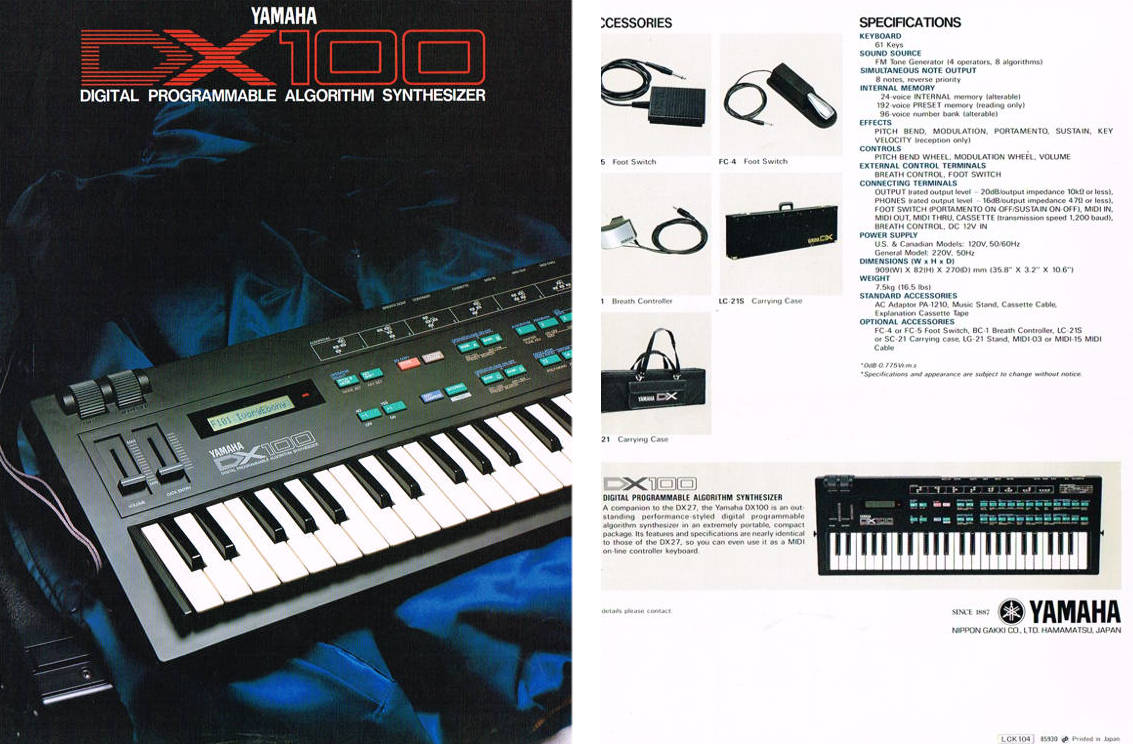
The DX100 was also featured on the rear of the DX27 Brochure because it was essentially a compact DX27.

A single sheet brochure with the DX27 on one side and the DX100 on the other.
1986 – The Final Countdown with second wave of DX synths.
Brown was out and Black came in. 1986 began with a rehash of the DX27 by changing it to black and building in speakers. There was also an SDX27 which was essentially the same instrument but badged for educational purposes in Japan. We have not been able to source any literature for any SDX synths. Around this time Yamaha in Japan also coined the phrase “feelin’ YAMAHA”, and printed this on the cover of many different publications.

Left- The original brochure for the DX27S is quite rare.
Right-The Japanese brochure variant and one of the first times we see “feelin’ YAMAMA” printed on the cover.
Yamaha then launched their Mk II DX7 synthesizers in the form of a DX7IID & DX7IIFD. The FD being a slightly superior model with its Floppy disk drive.

Left- The International brochure was a multi-page investment to fully explain all the advancements that the new flagship models contained. Interestingly this was the first and only brochure to feature mat finished paper which somehow does not do justice to the graphics. We’ve always been curious about the art piece underneath the synthesizer on the cover. Can anyone shed some light on that?
Right- In Japan the MkII was marketed as the SUPER DX and had a 3-page fold out brochure which also included the RX5 and TX81Z.
1987 – The reign of the DX continues
1987 marked the company’s 100-year anniversary and a lot of sales literature (especially in Japan) had a small 100-year logo printed on the bottom right corner.

YAMAHA 1887-1987 – a centenary celebration.

Left- Yamaha introduce the DX7S which was basically the old DX7 cleaned up and re-clothed in an updated body. “S” supposedly meant “Special”, though in our opinion it was not that special and we are not sure why it was needed.
Right- The Japanese DX7S brochure was different and we like that impractical but funky stand.
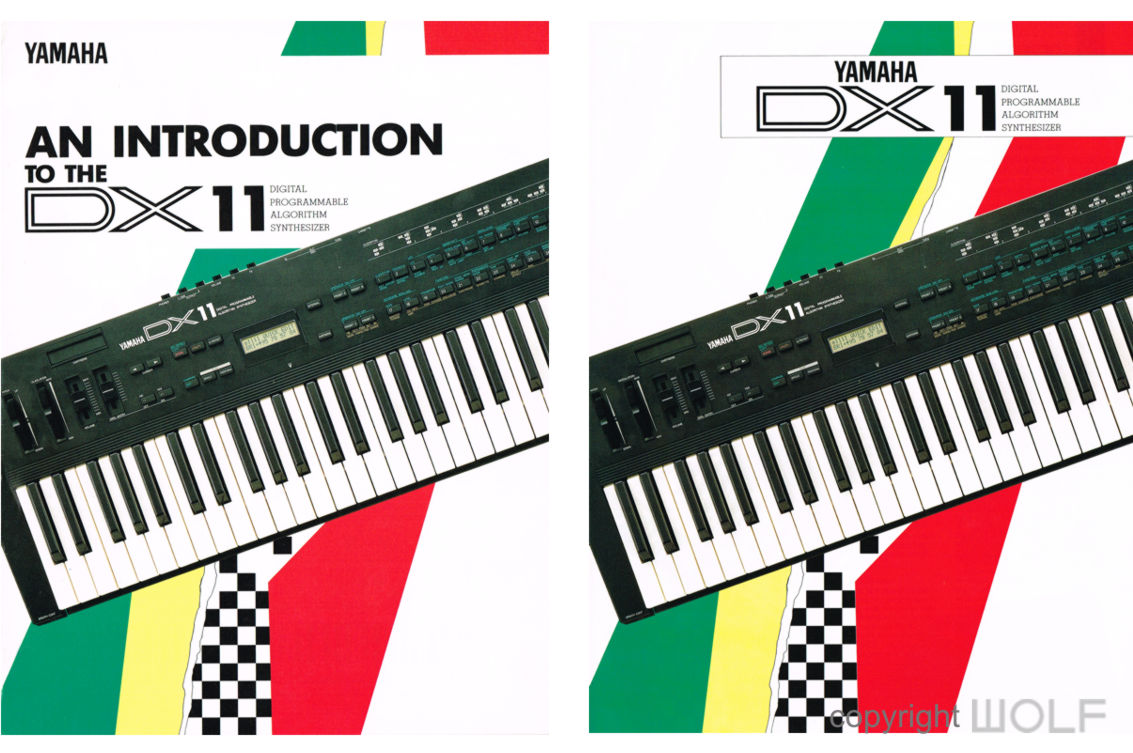
The DX11 is a favourite of ours from a design perspective, and the brochure had quintessential 80’s style graphics. In Japan the DX11 was labelled the V2, but we have yet to sight a specific individual brochure for the V2.
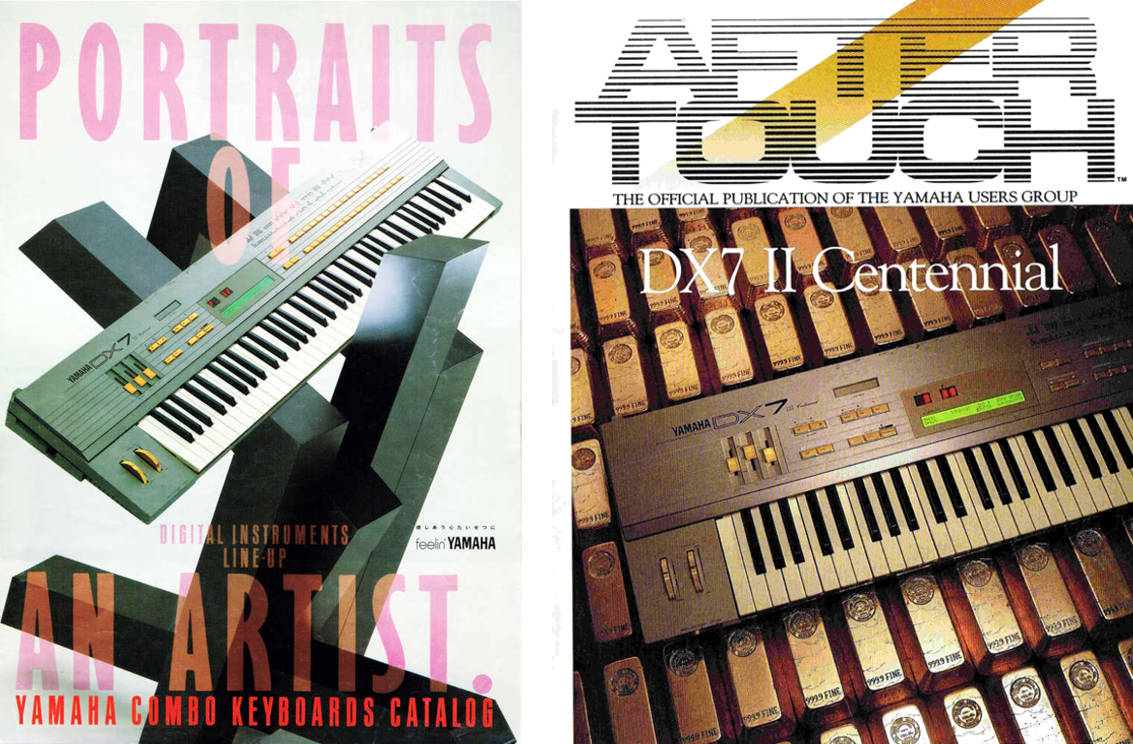
The DX7C was a very special and unique concept but did not seem to have its own brochure, possibly due to being sold in very limited numbers (only 100 apparently). It was however featured on the cover of a Yamaha’s Combo catalog as well as the December 1987 issue of After Touch.
1988 – The DX era comes to a close
Roland’s D-50 and Korg’s M1 entered the market at an opportune time when the DX range was looking stale and levelled the playing field. Yamaha needed a new flagship to regain leadership but the meantime experimented and explored alternative and affordable synthesizers with their YS, B and DS synthesizers. In Japan these were branded as EOS instruments which stood for “Entertainment Operating System/synthesizer”.
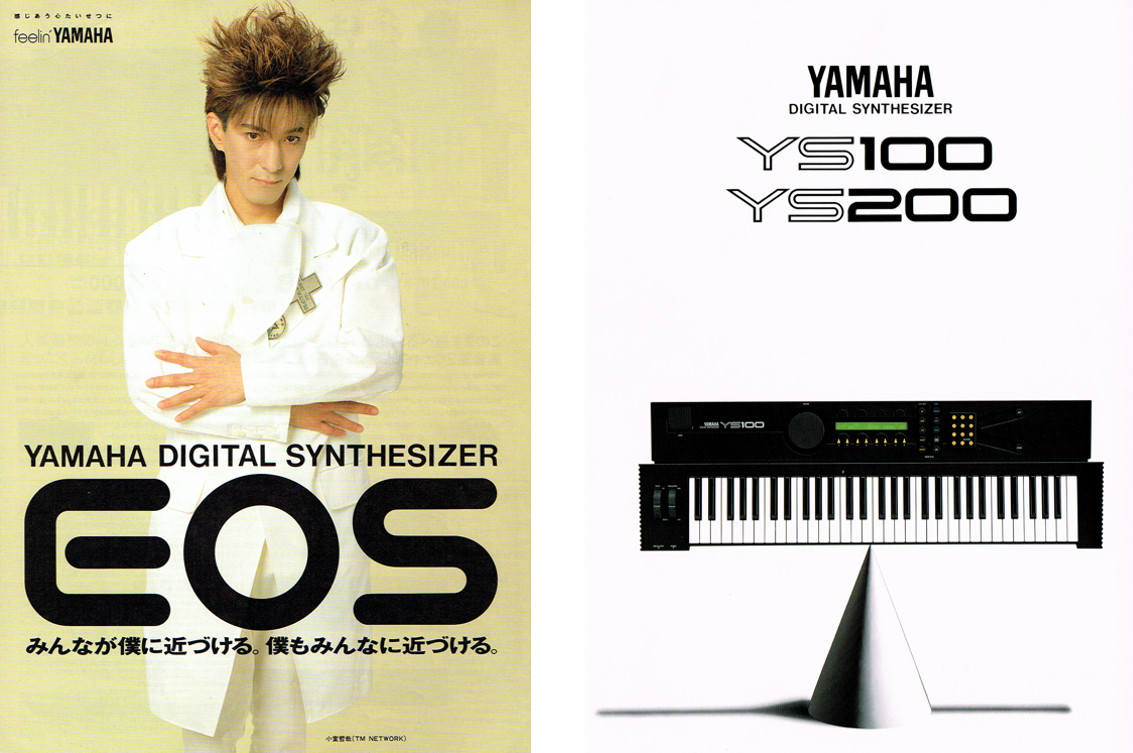
Left- This Japanese brochure for the EOS range features Komuro Tetsuya and is only the second time a person is featured on the cover of a Yamaha synth brochure since the CS01. Komuro Tetsuya strongly supported Yamaha’s EOS line and was featured on most EOS synth brochures and sales literature.
Right- The design of international brochure for the YS100 and YS200 were minimalistic but artistic as was the design of the synthesizers themselves.

Left- The B200 was would be the first of several more B synths to come. In Japan they also had variant badged as the SDX2000.
Right- The humble DS55 was one of the most affordable Yamaha synths built to date.
1989 – The SY era
It was a time of Romplers and Workstations, and Yamaha had in mind a new range designated by “V” with the V-80FD intended as the new flagship and demonstrated at the NAMM show in 1989. However only the V-50, a smaller sibling version made it into production. Instead the SY77 was announced and released towards the very end of 1989 as the new flagship model.

Left- The original sales brochure.
Right- In Japan the V-50 had a larger format brochure and interestingly emphasized two yellow curved lines to accentuate the curved profile of the synthesizers design.

Left- The original sales brochure for the SY77 is one of our favourites. It is one of the few brochures that illustrates the synthesizer as a whole from the front, similarly to the DX7IIFD. We like the combination of rising or setting sun on the horizon together with fog over a fluid blue surface.
Right- In Japan the SY77 had a specific brochure to explain the SY77’s RCM system. They used the infinity symbol as a logo for their RCM system.
1990 – More SY
Following the success of the SY77, Yamaha released a series of smaller and more affordable SY options.
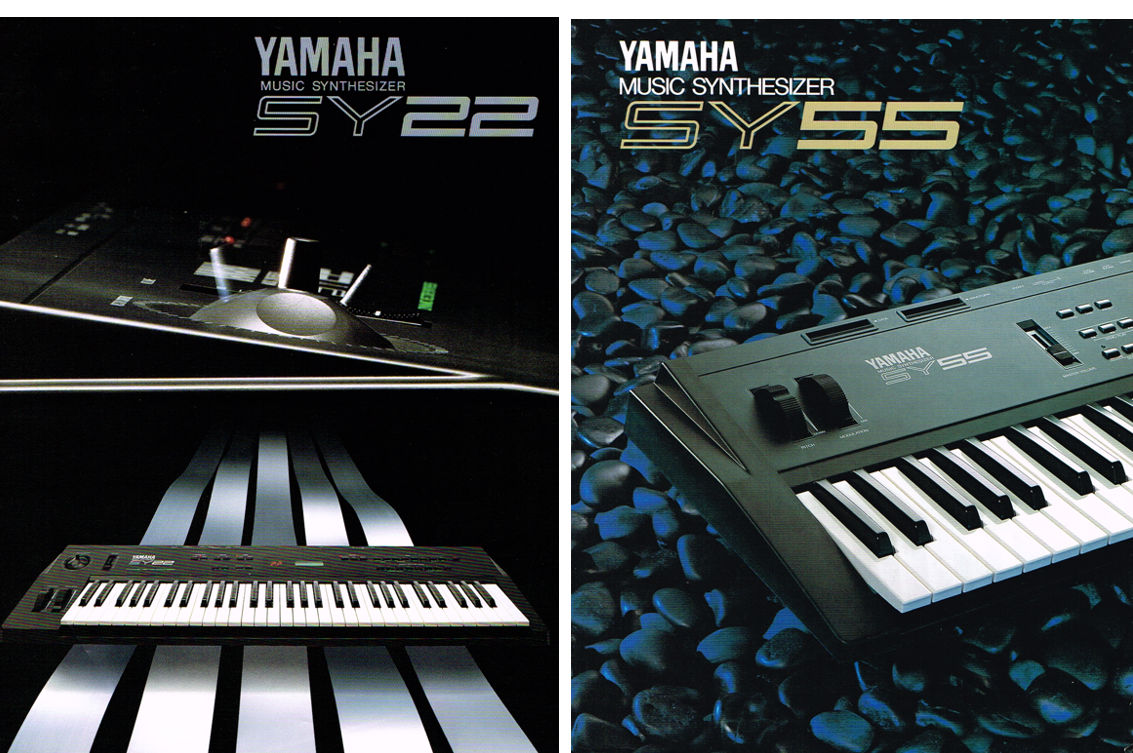
The SY22 on rows of metal strips & the SY55 on a bed of black pebbles.

Left- The SY77 also featured on the cover of a brochure promoting sound and data cards for SY and TG products. Right- In Japan this brochure showcased the SY77, SY55 & SY22 with the infinity symbol on the cover.

In Japan the B series continued with the B500.
1991 – A new King
In 1991 Yamaha released just one new synthesizer, but arguably was one of Yamahas best works though considered very expensive at the time.

As a flagship model we find the brochure design slightly underwhelming.

In Japan the SY99 featured on the cover of their digital instruments product catalogs.
1992 – Goodbye SY
In 1992 Yamaha prolonged the life of the SY series with two final releases in the form of the SY35 and SY85. While the SY85 is one of our least favourite of Yamaha’s designs it was intended as an affordable alternative to the SY77 & SY99.

The SY35 & SY85 brought the SY family to conclusion with 6 models in total.

Left- For some reason Yamaha printed a second brochure for the SY85 which in our opinion was rather lifeless and out of character from Yamaha.
Right- In Japan there was also a black and white brochure to introduce the new models. Both these publications were simple and generic which seems an indication of cost saving measures.
1993 – Hello VL
1993 was all about the new VL synthesizer, which till present day is arguably one of Yamaha’s finest technological marvels.

Left- The first VL1 brochure.
Right- In Japan the VL1 had a different brochure emphasizing the warmth and woodiness of the instrument with literally a piece of drift wood suspended above the synthesizer.

The EOS B-series continued further again in Japan with the B700
1994 – 20 years on and going strong
1994 saw the VL line continue with the VL7 & VP1. Little is known about the VP1 as it is believed that less than ten were produced. It is undoubtedly the rarest of all Yamaha synths.

The VL1 featured here on the cover of a 1994 Japanese product catalog

Like the limited edition DX7 Centennial (1987), we don’t believe an individual product brochure for the VP1 exists because of its limited numbers. However, it was featured inside a 1994 Japanese product catalog.

Here we see the VP1 listed for sale at 2,700,000, approx. $17,000 US, a staggering amount considering that was 30 years ago.
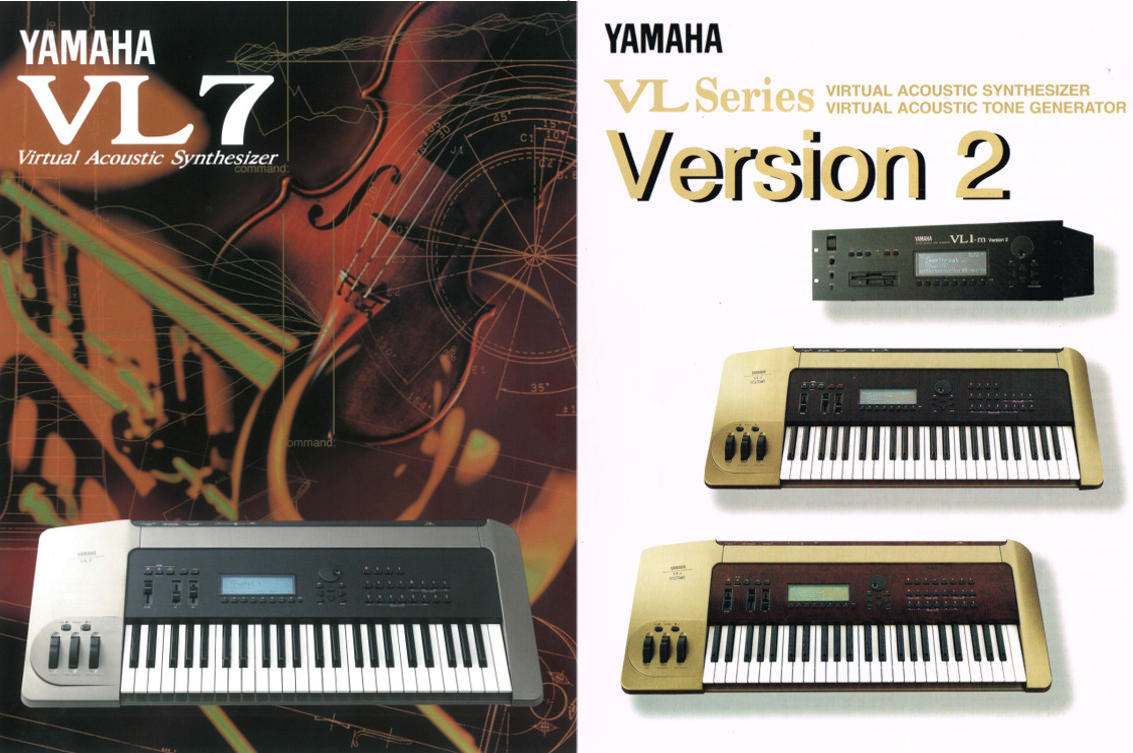
Left- The VL7 was an affordable alternative to the VL1.
Right- The VL1 was also updated with a version 2 upgrade and had an updated brochure that featured also the VL7 and VL1m.

Above- This Japanese brochure above for the VL7 also includes the Vl1 & VP1 and is the only evidence of cases for the VL1. The cases were listed as the VL1F & VL1H, but no images or photos have been seen in all of our research.

1994 also saw the launch of the W5 & W7 workstations which at first appeared to be new flagship synths, but in reality, was neither a revolution or evolution from the SY77 & SY99. The brochure cover design could probably have been a little more interesting. The W7/W5 brochure was the first Yamaha synthesizer brochure to feature the general midi logo (bottom right corner).
1995 – The lost years
Music production was in flux and to play it safe Yamaha repackaged the W7 into the QS300 and released yet another B synthesizer.

The QS300 was the first Yamaha synthesizer brochure to feature “XG” next to the general midi logo
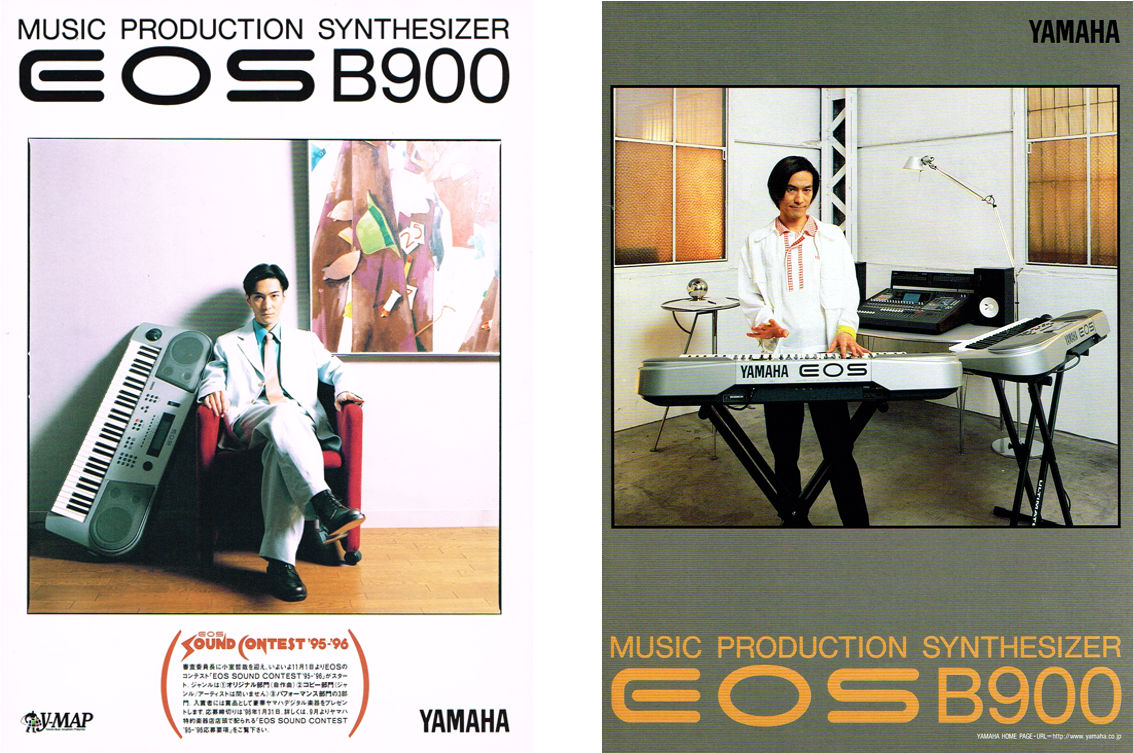
The EOS B900 that was only sold in Japan had two brochures that we know of. Japan also rebranded the B900 into an SDX3000 for use in schools. To the best of our beliefs no brochures for any SDX models exist.
1996 – Blue era
For the first time Yamaha chose to create synthesizers in blue colour.

The CS1X was Yamaha’s attempt to influence Rave, Dance and Techno music, and had these two brochures.

The B900 was updated in blue and called the B900EX
1997
1997 saw just one new synth release, the AN1X

1998 – Enter the EX
After a relatively quiet period, Yamaha came back strong with 6 new synthesizers. Finally, a worthy successor to the mighty SY99, with the new flagship EX5 and EX7 synthesizers. The B series also comes to final conclusion in the form of an EOS B2000.

Left- The Japanese Brochure emphasized the swoosh curve shape on the left end of the instrument.
Right- The international brochure with recording studio in the background.

Left- We don’t know of any individual brochures for the B2000, but it is shown here in a Yamaha 1999 Japanese product catalog alongside a white B2000W.
Right- the EX5 was also released in silver as a limited edition EX5S, supposedly in celebration of the pending new millennium. This would be the first time Yamaha experimented with silver since the DX7C some 11 years prior. We don’t think there was an individual brochure for the EX5S.

Left- The CS2X was an evolution of the CS1X with silver being the new blue and colour of choice for the start of the new millennium.
Right- The Japanese brochure for the CS2X
1999 – Getting ready for the new Millennium
For 1999 Yamaha released an even more powerful CS synth in the form of the CS6X. At the same time they created the S80 synth which was similar internally to the CS6X but packaged more as an all-round stage/studio instrument with weighted piano styled keys.


Word of the Wolf
So, there you have it, all of Yamaha’s synthesizers produced in the last century showcased through the colourful world of sales brochures. In this modern era where we co-exist with the cyberworld, the physical paper brochure is becoming a thing of the past and should be cherished and preserved. It’s good to see the rise in brochure collectors in recent years with strong demand for certain brochures that are especially rare. We hope you enjoyed this journey and do reach out to us if you are able to fill in any gaps in our story.
Disclaimer
The information in this review is intended for informational or educational purposes to provide readers an understanding of how something may be seen from a certain design perspective. In this case it is from the view point of WOLF DESIGNS. As design is subjective this review should only be considered as an independent opinion. Information further to being of an opinion is provided to the best of our knowledge based on our own research at the time of doing the review. We cannot be held responsible for any inaccuracies or inconsistencies and reserve the right to change or update any content as appropriate.
The final responsibility of the design resides with the original manufacturer.

